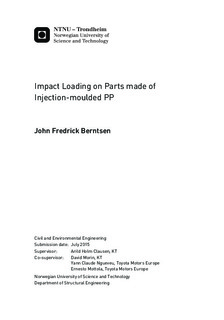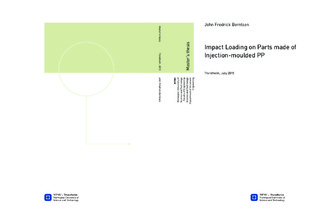| dc.contributor.advisor | Clausen, Arild Holm | |
| dc.contributor.advisor | Morin, David | |
| dc.contributor.advisor | Ngueveu, Yann Claude | |
| dc.contributor.advisor | Mottola, Ernesto | |
| dc.contributor.author | Berntsen, John Fredrick | |
| dc.date.accessioned | 2015-10-05T15:16:43Z | |
| dc.date.available | 2015-10-05T15:16:43Z | |
| dc.date.created | 2015-07-27 | |
| dc.date.issued | 2015 | |
| dc.identifier | ntnudaim:12807 | |
| dc.identifier.uri | http://hdl.handle.net/11250/2351276 | |
| dc.description.abstract | This project is set as a part of the ongoing development of the constitutive model the SIMLab Polymer Model (SPM) developed at SIMLab, NTNU. The goal with this thesis is to explore the capabilities of this model using two validation cases set up in cooperation with Toyota Motor Europe (TME). The validation cases are designed with the purpose to reproducing similar loading conditions and deformations as observed in pedestrian protection tests on full cars.
The experimental part of this thesis was performed with a standard drop tower. The test components are both made of a PP material provided by Toyota. The test specimen for the first validation case is a generic test box with a simple geometry. The test results show generally low test variability. However there are some problems with imperfections on the boxes. The test specimen for the second validation case is a lower absorber provided by TME. The tests results show significant test variability in the first series of tests as the fixtures were not properly handled, the second series of tests show very consistent results.
The majority of the work done during this thesis is in the two numerical studies performed on the box and the lower absorber respectively. The overall results of the box study show that high accuracy is achieved prior to fracture occurring. The box study highlights some key properties of this type of problems. Firstly that it is very sensitive to geometry, and secondly that fracture is in its current state unreliable. Fracture is seen to be very mesh dependent and to require heavy models.
The results of the lower absorber study show good accuracy using the SPM and a significant improvement compared to a standard material model. This improvement is due to how the SPM is able to better capture key physical properties of the ductile polymer like viscoelasticity and pressure sensitivity. The added complexity of the SPM comes at a significant cost in terms CPU. It is also observed that for complex geometries as the lower absorber a solid model may be needed to fully capture all the critical events. | |
| dc.language | eng | |
| dc.publisher | NTNU | |
| dc.subject | Bygg- og miljøteknikk, Beregningsmekanikk | |
| dc.title | Impact Loading on Parts made of Injection-moulded PP | |
| dc.type | Master thesis | |
| dc.source.pagenumber | 85 | |

